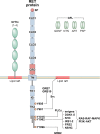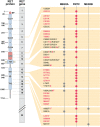Multiple endocrine neoplasia type 2 and familial medullary thyroid carcinoma: an update
- PMID: 23744408
- PMCID: PMC5399478
- DOI: 10.1210/jc.2013-1204
Multiple endocrine neoplasia type 2 and familial medullary thyroid carcinoma: an update
Abstract
Context: Over the last decade, our knowledge of the multiple endocrine neoplasia (MEN) type 2 syndromes MEN2A and MEN2B and familial medullary thyroid carcinoma (FMTC) has expanded greatly. In this manuscript, we summarize how recent discoveries have enhanced our understanding of the molecular basis of these diseases and led to improvements in the diagnosis and management of affected patients.
Evidence acquisition: We reviewed the English literature through PubMed from 2000 to the present, using the search terms medullary thyroid carcinoma, multiple endocrine neoplasia type 2, familial medullary thyroid carcinoma, RET proto-oncogene, and calcitonin.
Evidence synthesis: Over 70 RET mutations are known to cause MEN2A, MEN2B, or FMTC, and recent findings from studies of large kindreds with these syndromes have clouded the relationship between genotype and phenotype, primarily because of the varied clinical presentation of different families with the same RET mutation. This clinical variability has also confounded decisions about the timing of prophylactic thyroidectomy for MTC, the dominant endocrinopathy associated with these syndromes. A distinct advance has been the demonstration through phase II and phase III clinical trials that molecular targeted therapeutics are effective in the treatment of patients with locally advanced or metastatic MTC.
Conclusions: The effective management of patients with MEN2A, MEN2A, and FMTC depends on an understanding of the variable behavior of disease expression in patients with a specific RET mutation. Information gained from molecular testing, biochemical analysis, and clinical evaluation is important in providing effective management of patients with either early or advanced-stage MTC.
Figures


References
-
- Brandi ML, Gagel RF, Angeli A, et al. . Guidelines for diagnosis and therapy of MEN type 1 and type 2. J Clin Endocrinol Metab. 2001;86:5658–5671. - PubMed
-
- Machens A, Niccoli-Sire P, Hoegel J, et al. . Early malignant progression of hereditary medullary thyroid cancer. N Engl J Med. 2003;349:1517–1525. - PubMed
-
- Paszko Z, Sromek M, Czetwertynska M, et al. . The occurrence and the type of germline mutations in the RET gene in patients with medullary thyroid carcinoma and their unaffected kindred's from Central Poland. Cancer Invest. 2007;25:742–749. - PubMed
-
- Frank-Raue K, Rybicki LA, Erlic Z, et al. . Risk profiles and penetrance estimations in multiple endocrine neoplasia type 2A caused by germline RET mutations located in exon 10. Hum Mutat. 2011;32:51–58. - PubMed
-
- Kloos RT, Eng C, Evans DB et al. ; American Thyroid Association Guidelines Task Force. Medullary thyroid cancer: management guidelines of the American Thyroid Association. Thyroid. 2009;19:565–612. - PubMed
Publication types
MeSH terms
Substances
Supplementary concepts
LinkOut - more resources
Full Text Sources
Other Literature Sources
Medical

